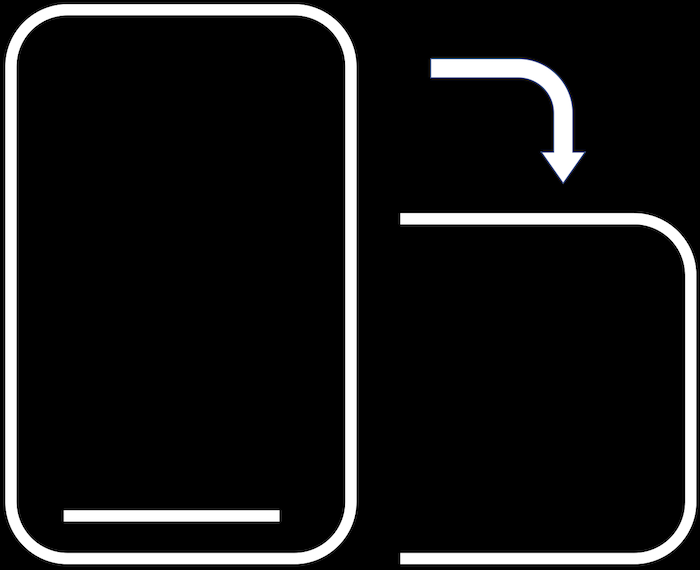where
The proton density filter is the portion on the right , the T1 filter is in the middle, and the T2 filter is the portion on the left
Because there is no spin echo, the T2 filter is really a T2* filter. T2* is a tissue property that describes relaxation of transverse magnetization due to local magnetic field inhomogenities. For the purpose of this chapter we are assuming that normal tissues have T2* = 20ms. When we talk about using a longer TE to introduce T2* weighting this will not be shown on the plots because we have assumed that T2* is the same for all normal tissues. These graphs also do not take in to account tissues with ultra-short T2 values where T2 is shorter than T2*. This chapter primarily discusses spoiled gradient echo image as it relates to T1 imaging.
Sequence weighting is still expressed as the first derivative of the tissue filter divided by the filter.
For the T1 filter using logarithmic axis this is
Relative image weighting is still the T1 signal difference between two tissues divided by the value of the filter at a T1 that is the average T1 of the two tissues. If the SPGR T1 tissue filter is denoted as then this becomes:
Small flip angles do not completely remove longitudinal magnetisation which shortens the recovery time and allows for shorter TRs. Shorter TRs result in faster acquisition times. However, dropping the flip angle decreases the maximum slope of the T1 filter and results in less T1 weighting plus less overall signal. Adjust the parameters to see this. For 2D imaging the flip angle and TR are usually only decreased a little. For 3D imaging small flip angles and very short TRs allow for acquisition of near isotropic volumes in short times. The low overall relative signal that results from a short flip angle and short TR is offset by the large number of spins flipped in a 3D volume acquisition.
Standard 3D T1 weighted SPGR sequences use a flip angle from 7-12 degrees, a TR from 4-7ms, and a TE as short as possible usually 1-4 ms. At these values the slope of the T1 filter in the region of most soft tissues is not very steep and there is little difference between most tissues. However, because most soft tissues have similar proton densities and we have assumed they have the same T2*, the image weighting is still most dependent on T1. To see this, set the flip angle to 12 degrees, the TR to 7ms and the TE to 3ms. These are approximately the parameters of the GE LAVA, Siemens VIBE, and Philips eThrive sequences.
Use liver and muscle as an example. Set Tissue 1 to liver and Tissue 2 to muscle using the drop down menues above on the right. Select liver and muscle in the list of tissues above on the left. For liver the sequence is 84% positively PD weighted, 4% negatively T1 weighted, and 13% positively T2* weighted. The T1 filter curve is so flat there is hardly any T1 weighting; i.e. little sensitivity to small changes in liver T1. However, because liver and muscle have approximately the same PD and T2* the difference in signal between them is 100% due to T1 weighting.
Do the same for white and grey matter. For white matter the sequence is 84% positively PD weighted, 3% negatively T1 weighted, and 13% positively T2* weighted. However, he difference in signal is 75% due to negative T1 weighting.
You can look at other combinations of tissues. Note that the above plots and calculations will not be accurate for ligaments or tendons where TE = 4ms but we have assumed T2* is 20ms for all tissues.
This sequence is not optimal for delineating many anatomic structures based on T1 but still does a good job in clinical practice. It is much better in the body where the contrast is between organs and fat, than it does in the brain where contrast is between grey and white matter. When high resolution, fast, T1 weighted anatomic images of the brain are needed an inversion recovery pulse is placed in front of the spoiled gradient readout. As discussed in the section on Inversion Recovery, a properly chosen inversion time will introduce high T1 weighting and contrast for fat, grey matter, and white matter. The spoiled gradient readout allows for a fast, high resolution acquisition.
Instead, 3D T1 weighted images are most commonly used in the body, muscles, and brain to look for areas of contrast enhancement. Contrast markedly decreases tissue T1 while keeping PD and T2* constant (except when highly concentrated as in the urine). This decrease shifts the T1 values of enhancing tissues far left on the T1 filter resulting in high signal and contrast compared to non-enhancing tissue. Fat suppression is often used in combination with these sequences to remove the high signal from fat to decrease the dynamic range of the image. MR Angiography sequences typically increase the flip angle to 30 which has the effect of further decreasing the signal and contrast between most soft tissues. Increase the flip angle to 30 to see. Because this higher flip angle suppresses the signal from fat compared to contrast, fat suppression is usually not used with contrast enhanced MR angiography. Only the contrast in the vessels (very short T1) has high signal.
A small flip angle, longer TR (> 100ms), and longer TE (20-50ms) result in strong T2* weighting. The T1 filter becomes flat and the T2* filter remains low signal for tissues with decreased T2*. Both iron and hemosiderin decrease tissue T2* and will appear dark while other tissues remain bright. This shifts the T2* filter towards the right resulting in low signal for tissues with iron and hemosiderin. Hemosiderin is an end product of hematoma evolution and is a marker of prior hemorrhage.
